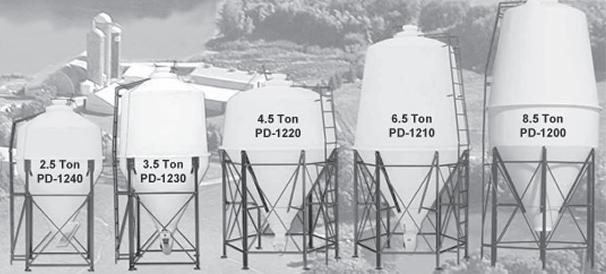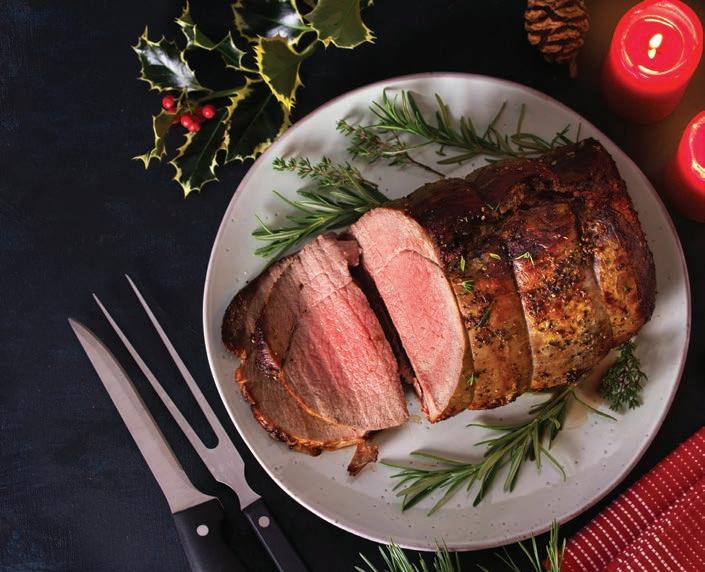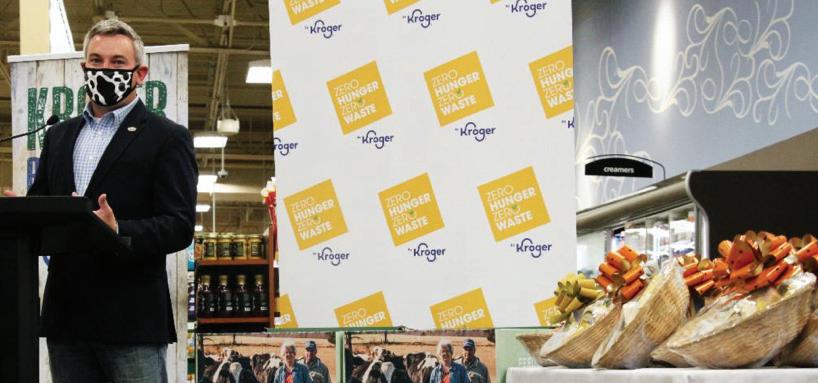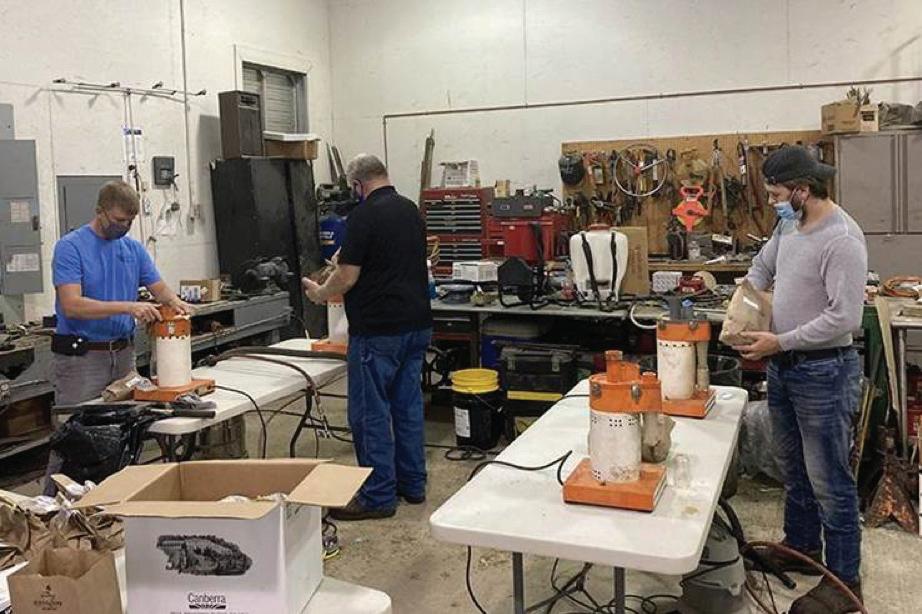
17 minute read
UK Begins On-Farm Variable Rate Irrigation Research
Katie Pratt, University of Kentucky
A University of Kentucky research project that could have significant impacts for Kentucky grain producers with irrigated acres is beginning on a Western Kentucky farm. Ole Wendroth, soil physicist in the UK College of Agriculture, Food and Environment, is leading a study examining the effects of a variable rate irrigation system that, to his knowledge, is the first-of-its-kind in the state. “When we irrigate, we practice environmental stewardship,” said Wendroth, a professor in the UK Department of Plant and Soil Sciences. “Irrigation keeps the soil wet, which means plant roots better penetrate the soil and take up nutrients. This lowers the amount of nitrogen in the soil and reduces our risk of nitrate leaching during the winter, when we tend to have a lot of rainfall.” Wendroth is conducting this research in partnership with Princeton farmer Trevor Gilkey at his Hillview Farms. The two men have worked together on various projects for more than 15 years, beginning with a variable rate nitrogen study. “I’m interested in conserving water, preventing runoff and putting the water where we need it, especially when we have different soil types within the same field,” Gilkey said. Historically, Kentucky farmers do not irrigate many acres compared to growers in drier climates. Often, the state receives adequate rainfall to produce a crop, but the rainfall does not always occur at the key growing times during the season, when crops need it the most. As a result, some producers have invested in irrigation over the past 20 years. This has created the need for research tailored to the state’s climate. “While we only have a small percentage of producers who irrigate, those producers have many center pivots and would benefit from research to help them figure out scheduling, develop a better understanding of soil-crop interactions and determine the thresholds for water application,” said Carrie Knott, director of the UK Research and Education Center and one of Wendroth’s research collaborators. “We hope to answer these questions through research studies like this one.” Gilkey’s field where the variable rate irrigation research is occurring is 137 acres and usually rotates between corn, wheat and double-crop soybeans. Not only does the field have Kentucky’s typical crop rotation, it also contains common soil types found in much of the state’s irrigated acres. “Our mission at the UK Grain and Forage Center of Excellence is to help farmers be more efficient, improve productivity and preserve the natural resources that they have, and we believe that practicing smart irrigation is a step toward achieving those goals,” said Chad Lee, center director and a research collaborator with Wendroth. “We believe the results from this study will be applicable to most Kentucky farms with center pivots.” Over the past five years, Wendroth and his graduate students have conducted extensive research on Gilkey’s farm. They have collected soil samples, identified soil fertility trends, created an intensive soil mapping system and developed what Wendroth believes is a variable irrigation prescription for the field. In this newest research project, Wendroth will be able to control the flow of water at each sprinkler. “As scientists we need to develop a sense for spatial variability out in the landscape, which is what farmers have to Water runs through the variable rate irrigation system recently installed on Trevor Gilkey’s farm in Princeton. The system will provide UK scientists with new and enhanced research opportunities. Photo by Ole Wendroth, UK soil scientist
deal with all the time,” Wendroth said. “If we know that water is not taken up by the soil at the same rate at different parts of the field, then we have to do something about it. We believe variable technology can work for us here.” The project is an effort of the UK Grain and Forage Center of Excellence and has received overwhelming support from the state’s agricultural groups. It has received funding from the Kentucky Corn Growers, Kentucky Small Grain Growers, Kentucky Soybean Promotion Board, Southern Soybean Research Program, Kentucky Farm Bureau’s Water Quality Initiative and Siemer Milling Company. Rebecca McCulley, chair of the Department of Plant and Soil Sciences, said it is scientist-farmer partnerships like the one Gilkey and Wendroth have that help advance agricultural science and improve farming practices. “To be able to take concepts that we develop in the lab and actually bring them into the field helps us to understand what pieces of our science we have right and what pieces are still a long ways from being right,” she said. “These partnerships are critical to be able to make sure we are spending time on the research side that is going to be translatable to people in the field doing the work.”
Tim Dievert 478 Dry Fork Rd. • Danville, KY 40422 Office:859/236-4591 (C)859/238-3195 • tdievert@dievertsales.com www.dievertsales.com
Catalogs or more information available by contacting Tim Dievert.
Central Kentucky Angus Association’s 58th Annual Fall Sale: 87 lots total 138,875 to average 1,596 10 bulls average 2,940 Commercial females: 14 pairs: average 1,655 39 bred heifers: 1,504 15 bred cows: 1,233 9 open heifers: 1,017
Central Kentucky Angus Association’s 57th Annual Winter Sale: January 16, 2021 • Danville, KY
Call Tim for consignment information
FEATURE RAPID DEATH IN FEEDER CALVES? IT MAY BE HISTOPHILUS SOMNI (FORMERLY KNOWN AS HAEMOPHILUS SOMNUS OR “SOMNUS”)
MICHELLE ARNOLD
DVM-Ruminant Extension Veterinarian, University of Kentucky
October and November are known as two of the most difficult months to buy feeder calves in KY due to major health challenges. Weather is often blamed but is just one of many risk factors that play a role in Bovine Respiratory Disease (BRD) development. This fall, the bacterium Histophilus somni (formerly known as Haemophilus somnus) has emerged as a major bacterial pathogen responsible for the rapid development of disease and death in feeder operations. While Mannheimia haemolytica, commonly called “Pasteurella”, is the bacterial species known to cause bronchopneumonia and rapid death, Histophilus somni (HS) can cause similar symptoms and is proving very difficult to treat and control with traditional methods. In addition, a more severe form of disease, known as the “septicemic form” has been seen in several cases submitted to the UKVDL over the last month. This septicemic form typically hits calves 30-60 days after arrival to the feed yard and the bacteria may affect the brain, heart, larynx, muscles, joints, liver and kidney in addition to the lungs. In some cases, the calves are simply found dead with no clinical signs. The septicemic form usually results in rapid death, generally less than 48 hours from development of symptoms up to the time of death. If the joints are involved, the calves may become noticeably lame or wobbly and the joints may become extremely swollen and looks similar to Mycoplasma bovis joint involvement. On necropsy, several of these cases have had laryngitis and edema (swelling) in the back of the throat because the bacteria have attacked the laryngeal muscles. “Somnus” is often found in combination with Pasteurella multocida in “biofilms” which are clusters of bacteria in a jelly-like matrix that serves as protection from antibiotics and host immune system responses. Stress can trigger bacteria to leave the biofilm and travel to the lungs. Once it establishes infection in the lungs, it can travel by the bloodstream to joints, organs (especially the heart), and to the brain. These calves may develop pneumonia, pleuritis (infection of the membrane surrounding the lungs), myocarditis (infection in the heart muscle), thrombotic meningoencephalitis (infection in the brain), tenosynovitis (infection within joints), laryngitis, and otitis media (middle ear infection). The disease can happen anytime in the year but most clinical cases occur between October and January. Previously, disease due to “Somnus” was found primarily in Northwestern and Midwestern states in the USA and Canada but cases are now being diagnosed throughout the US, including Kentucky. Most comprehensive studies have been conducted in Canada where “Somnus” accounts for an estimated 40% of the death loss in feedlots. Unlike typical BRD outbreaks that peak at 14 days after arrival to the feedlot, “Somnus” pneumonia cases peak at 25 days on feed. In the absence of consistently effective treatment or vaccine options, management practices are crucial to controlling death loss. Metaphylaxis, the practice of treating the whole group of calves with a longacting antibiotic on arrival to the feed yard (or delay mass treatment until 10 % of the calves are showing clinical symptoms of pneumonia), along with prompt pulling and treatment of sick cattle is one recommended approach. Vaccines are available against “Somnus” but protection is by no means complete from these products. The common BRD-associated bacteria (Mannheimia haemolytica, Pasteurella multocida, and Histophilus somni) are found in the nasal passages of healthy calves but with stress (such as transportation and commingling) and viral infection, the bacteria can descend into the lungs and sometimes spread throughout the body, causing disease. In reality, multiple factors contribute to complex interactions between the environment, the bacteria and viruses, and the calf’s immune system. Stressed calves are more susceptible to viral infection by Infectious Bovine Rhinotracheitis (IBR), Bovine Viral Diarrhea virus (BVD), Parainfluenza 3 virus (PI3), Bovine Respiratory Syncytial virus (BRSV) and possibly another agent, Bovine Coronavirus (BCV). Viruses are known to damage the lining of the respiratory tract and some will actually suppress the immune system, giving bacteria “a green light” to enter and grow in the lungs (pneumonia). Combinations of different bacterial species can work synergistically to cause more severe disease than if operating alone. There are no easy ways to tell if “Somnus” is part or all of the disease problem, other than it tends to occur later after arrival than most cases of BRD. The Histophilus somni Disease Complex (HSDC) is a term used to describe the disease when “Somnus” reaches the lungs and also lands in the brain, heart and joints. Components of the HSDC include:
Rapidly Fatal Pneumonia: Some animals with “Somnus” pneumonia are simply found dead due to lung damage called “severe fibrinous pleuritis”. This is a common finding in western Canadian feedlots and is seen 30-90 days after arrival. The lungs are usually the only organ affected and are found covered in a thick sheet of fibrin, a tough protein substance made up of long fibrous threads, while the lungs themselves are collapsed underneath.
Bronchopneumonia: Some calves with “Somnus” develop typical signs of BRD including depression, off feed, cough, excessive nasal discharge and difficult or rapid breathing.
Respiratory signs with fever of 104°F or above confirms the diagnosis of
BRD but detection of the bacteria and/or viruses involved must be done at a diagnostic laboratory. Treatment is often very difficult and unrewarding in the field when “Somnus” is involved although in the laboratory, the “Somnus” bacterium is usually susceptible to many antibiotics.
Heart Muscle damage: “Somnus” can cause a “necrotizing myocarditis” when it localizes in the muscles of the left ventricle of the heart. Death can be rapid with no previous signs (similar to a heart attack) or chronic forms lead to “poor doers”.
Thrombotic meningoencephalitismyelitis or “TME”: This is a disease of older calves and yearlings affecting the brain. During an outbreak, individual cases occur sporadically in separate pens in a feed yard.
Signs include depression, fever, blindness, down and death; this can look similar to signs seen with polioencephalomalacia or “brainers”.
Treatment with antibiotics is most often unrewarding.
Other Manifestations: Arthritis with joint swelling, laryngitis and middle ear infections with drainage from the ear canals may also be seen. Diagnosis of Histophilus somni disease in a live calf is challenging because it is present in the upper airways of both healthy and diseased calves so swabs taken from deep in the nose will not necessarily tell the story of what is causing disease in the lungs and elsewhere. “Somnus” is difficult to grow in the laboratory, especially if the calf was treated with antibiotics, so the PCR assay is strongly recommended in addition to culture for detection. Mixed lung infections with other disease- causing
bacteria such as Mannheimia haemolytica and Pasteurella multocida can easily overgrow Histophilus somni on a culture plate so the identification may be missed when relying on traditional bacterial culture methods alone. Culture is still important to identify what antibiotics should be effective. Unfortunately, the transfer of genetic elements that caused antimicrobial resistance to develop in Mannheimia haemolytica is also now found to be operating in Histophilus somni. Prevention is difficult. This is not a disease complex managed through a needle. What we do in the first 14 days after purchase is crucial because we can’t reverse the damage done by this disease. Biosecurity and biocontainment practices must be followed. Because “Somnus” pneumonia and septicemia often develop along with viral infections (especially BVD) or in combination with other bacterial pathogens, control should begin with minimizing wellrecognized factors predisposing to BRD. Stress plays a major role in disease through immunosuppression so excellent nutrition and management are critical. There is no direct proof that “Somnus” vaccines are effective under field conditions but they may help lessen the severity of the brain form of disease. Consult with your local veterinarian for the best management plan for your operation. The following steps should help reduce the risk of pneumonia in feeder calves:
Vaccination with a modified live (MLV) 5-way respiratory virus vaccine and a Mannheimia haemolytica toxoid (“Pasteurella”) after calves have rested 24 hours is the traditional protocol for feeder calves on arrival.
However, since vaccines usually cause calves to have a slight fever, new research has shown the MLV vaccine may be delayed 2-3 weeks in high risk calves without affecting the morbidity and mortality rate. In other words, if you are concerned the newly purchased calves are at high risk to get sick, delaying vaccination until they are stronger will not result in more sickness and death than you would have had anyway. As a matter of fact, it may help keep them eating and drinking better without the vaccine-induced fever.
Cattle with extremely low blood concentrations of the trace elements selenium and copper have difficulty fighting any disease challenge. An injectable trace mineral supplement (such as Multimin 90®) is one option to boost the copper and selenium levels during the initial arrival period. Metaphylactic treatment (treatment of all calves on arrival or when 10% show signs of BRD) of high risk calves (high risk=lightweight, weaned on the trailer, commingled, green calves) with long-acting antibiotics is a well-established, beneficial procedure that can reduce morbidity (sickness) and case fatality (death) by up to 50% in high risk calves. Be aware that overconfidence in and reliance on metaphylaxis and longacting antibiotics can lead to delayed follow-up treatment if calves are not adequately monitored. In other words, calves still need to be watched very closely in spite of having an antibiotic on board. Feed bunks and watering troughs are known areas for disease transmission. Keep sick cattle, especially chronic pneumonia calves, away from healthy calves and manage their feed and water separately. Do not allow noseto-nose contact between sick and healthy groups. Do not pen new arrivals next to calves that were purchased last week! Try to load your farm with calves as quickly as possible rather than buy a load every week for 4 weeks and combine them in same area. This is a sure-fire recipe for disaster. Management is key. In a recent article by Chad Engle from the US Meat Animal Research Center, he wrote, “I like to think of our feed yards as five-star hotels. Once these calves step into our “hotel”, they should be greeted by knowledgeable handlers, fresh feed, clean waterers and clean pens. We never put new calves into pens that do not have fresh hay and ration in the feed bunks. It is our job in the feed yard to show those calves that the feed yard is the best place on earth for them to be.” Enough said. Good sanitation, especially regularly cleaning and sanitizing waterers, feed bunks and working chutes is imperative. Buying preconditioned calves that have been weaned and vaccinated for respiratory diseases prior to weaning (especially BVD) and dewormed will
help decrease, but does not eliminate, sickness and death loss. In summary, the disease syndrome caused by Histophilus somni may have Allison Charolais many different clinical signs besides the typical pneumonia symptoms. Disease onset may be rapid and response to antibiotic therapy is frequently very poor. Allison Charolais Charolais Breeder Since 1962 •Allison Charolais Diagnosis in a live calf can be difficult since “Somnus” is often recovered from nasal swabs of healthy calves so the presence of the bacteria in the nose of a sick calf does not prove it is causing disease. It is also a difficult bacterium Charolais Breeder Since 1962 • Bulls Available Ø Bull calves out of HCR Answer 2042 and CHAROLAIS Bulls Available Ø Bull calves out of HCR Answer 2042 and HCR SPIRIT 4007. Charolais Breeder Since 1962 • Bulls Available to grow in the laboratory, especially if the calf has been recently treated with antibiotics. Future research will focus on the relationship between “Somnus” and HCR SPIRIT 4007. Ø Bred for calving ease and growth. Ø Bulls for both purebred and commercial breeders. BULLS & HEIFERS Ø Bred for calving ease and growth. Ø Bulls for both purebred and commercial breed Ø Bull calves out of HCR Answer 2042 and HCR SPIRIT 4007. other respiratory pathogens, developing improved diagnostic tests, monitoring antibiotic efficacy and development of effective vaccines for prevention of disease. In the meantime, make your feed yard a five star hotel for calves to help prevent, rather than treat, disease. Ø Yearlings and two-year-olds available. Ø Bred heifers to calve in fall available. John Allison, Owner 545 Eminence Road New Castle, KY 40050 502-220-3170 David Carter, Farm Manager 502-706-0075 AVAILABLE John Allison, Owner 545 Eminence Road Ø Yearlings and two-year-olds available. Ø Bred heifers to calve in fall available. John Allison, Owner 545 Eminence Road David Carter, Farm Manager 502-706-0075 Ø Bred for calving ease and growth. Ø Bulls for both purebred and commercial breeders. Ø Yearlings and two-year-olds available. Ø Bred heifers to calve in fall available. New Castle, KY 40050 New Castle, KY 40050 502-220-3170John Allison, Owner David Carter, Farm Manager
GREEN RIVER LIVESTOCK CAMPBELLSVILLE, KENTUCKY
PolyDome Bulk Bins • Translucent polyethylene allows you to see material level • Made from high-impact, UV stabilized polyethylene • Corrosion resistant • Easy cleaning • Smooth surface reduces bridging • Large, vented filler cap with pull rope for ground access • Sturdy outside ladder • 10 year warranty! Bins in Stock & Ready to Move!

Lick Tanks also available!

GIVE DARREL A CALL FOR ALL OF YOUR FEED BIN AND CATTLE HANDLING EQUIPMENT NEEDS!
DARREL EASTRIDGE • 270-469-5389
PRIVATE TREATY SALES CHECKOFF INVESTMENT FORM State and National Beef Promotion and Research Programs Information is required by 7 CRF 1260.201. Failure to report can result in a fine. Information is held confidential per 7 CRF 1260.203.
TODAY’S DATE
SELLER’S NAME
ADDRESS
CITY
SELLER’S SIGNATURE STATE ZIP ID NUMBER (IF KNOWN)
BUYER’S NAME
ADDRESS
CITY
BUYER’S SIGNATURE STATE ZIP
Both the seller and the buyer are responsible for making sure that the $1 per head assessment is collected and remitted to the Kentucky Beef Council.
DATE OF SALE STATE OF ORIGIN*
TOTAL NUMBER OF CATTLE SOLD
X
$1.OO per Head Federal Checkoff
X
$1.OO per Head State Checkoff
Total Checkoff Payment for Federal and State
PERSON REMITTING FORM
PHONE BUYER SELLER
*If the cattle purchased came from another state within the last 30 days, indicate from which state the cattle were purchased.
Send Report and Remittance to:
Kentucky Beef Council 176 Pasadena Drive Lexington, KY 40503 For additional information: call 859-278-0899 or email beef@kycattle.org
According to the Paperwork Reduction Act of 1995, an agency may not conduct or sponsor, and a person is not required to respond to a collection of information unless it displays a valid OMB control number. The valid OMB control number for this information collection is 0581-0093. The time required to complete this information collection is estimated to average 1 hour per response, including the time for reviewing instructions, searching existing data sources, gathering and maintaining the data needed, and completing and reviewing the collection of information. The U.S. Department of Agriculture (USDA) prohibits discrimination in all its programs and activities on the basis of race, color, national origin, age, disability, and where applicable, sex, marital status, familial status, parental status, religion, sexual orientation, genetic information, political beliefs, reprisal, or because all or part of an individual’s income is derived from any public assistance program. (Not all prohibited bases apply to all programs.) Persons with disabilities who require alternative means for communication of program information (Braille, large print, audiotape, etc.) should contact USDA’s TARGET Center at (202) 720-2600 (voice and TDD). To file a complaint of discrimination, write to USDA, Director, Office of Civil Rights, 1400 Independence Avenue, S.W., Washington, D.C. 20250-9410 or call (800) 795-3272 (voice) or (202) 720-6382 (TDD). USDA is an equal opportunity provider and employer.





